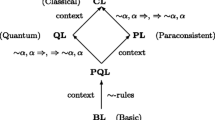Abstract
This article proposes a basic logic for application in physics dispensing with the Principle of Excluded Middle. It is based on the article “Matrix Based Logics for Application in Physics (RMQ) which appeared 2009. In his article with Stachow on the Principle of Excluded Middle in Quantum Logic (QL), Peter Mittelstaedt showed that for some suitable QLs, including their own, the Principle of Excluded Middle can be added without any harm for QL; where ‘without any harm for QL’ means that the basic desiderata and the basic results (theorems) of those QLs remain satised in the sense that they avoid the well known difficulties with commensurability and distributivity.
In the following article I want to show that the basic desiderata and results (theorems) of RMQ (of avoiding the well-known difficulties with commensurability, distributivity, fusion and Bell’s inequalities) remain satised if by introducing a strong negation (or strong negation and disjunction) the resulting weak intuitionist system RMQI dispenses with the Principle of Excluded Middle; it becomes either invalid or not strictly valid.
Similar content being viewed by others
References
Aerts, D.: A possible explanation for the probabilities of quantum mechanics and example of a macroscopical system that violates Bell inequalities. In: Mittelstaedt, P., Stachow, E.W. (eds.) Recent Developments in Quantum Logics, pp. 235–249. B.I. Wissenschaftsverlag, Mannheim (1985)
Aerts, D., Aerts, S.: Towards a general operational and realistic framework for quantum mechanics and relativity theory. In: Elitzur, A., Dolev, S., Kolenda, N. (eds.) Quo Vadis Quantum Mechanics? pp. 153–207. Springer, Heidelberg (2005)
Bell, J.: Speakable and Unspeakable in Quantum Mechanics. Cambridge University Press, Cambridge (1987)
Birkhoff, G., von Neumann, J.: The logic of quantum mechanics. Ann. Math. 37, 823–843 (1936)
Dalla Chiara, M.L., Giuntini, R.: Quantum logics (2001). arXiv:quant-ph/0101028v2
Dalla Chiara, M.L., Giuntini, R., Greechie, R.: Reasoning in Quantum Theory, Sharp and Unsharp Quantum Logics. Kluwer, Dordrecht (2004)
D’Espagnat, B.: A la Recherche du Réel. Gauthier–Villars, Paris (1979)
Finkelstein, D.: Matter, space and logic. In: Hooker, C.A. (ed.) The Logico-Algebraic Approach to Quantum Mechanics, vol. II, pp. 123–139. Springer, Berlin (1979)
Goldblatt, R.: Semantic analysis of orthologic. J. Philos. Log. 3, 19–53 (1974)
Mittelstaedt, P.: Quantum Logic. Reidel, Dordrecht (1978)
Mittelstaedt, P.: Consulting, naming and identity in quantum logic. In: Recent Developments in Quantum Logic, pp. 215–234. P.I. Wissenschaftsverlag, Mannheim (1984)
Mittelstaedt, P.: The Interpretation of Quantum Mechanics and the Measurement Process. Cambridge University Press, Cambridge (1998)
Mittelstaedt, P.: Does quantum physics require a new logic? In: Weingartner, P. (ed.) Alternative Logics. Do Sciences Need Them? pp. 269–284. Springer, Heidelberg (2004)
Mittelstaedt, P., Stachow, E.W.: The principle of excluded middle in quantum logic. J. Philos. Log. 7, 181–208 (1978)
Mittelstaedt, P., Weingartner, P.: Laws of Nature. Springer, Heidelberg (2005)
Piron, C.: Axiomatique quantique. Helv. Phys. Acta 37, 439–468 (1964)
Schurz, G., Weingartner, P.: Verisimilitude defined by relevant consequence-elements. A new reconstruction of Popper’s original idea. In: Kupiers, T. (ed.) What is Closer-to-the-Truth? pp. 47–77. Rodopi, Amsterdam (1987)
Tarski, A.: Logic Semantics and Metamathematics. Oxford University Press, Oxford (1956)
Weingartner, P.: Modal logics with two kinds of necessity and possibility. Notre Dame J. Form. Log. 9(2), 97–159 (1968)
Weingartner, P.: Applications of logic outside logic and mathematics: Do such applications force us to deviate from classical logic? In: Stelzner, W. (ed.) Zwischen Traditioneller und Moderner Logik, pp. 53–64. Mentis, Paderborn (2001)
Weingartner, P.: Reasons from science for limiting classical logic. In: Weingartner, P. (ed.) Alternative Logics. Do Sciences Need Them? pp. 233–248. Springer, Heidelberg (2004)
Weingartner, P.: Matrix-based logic for application in physics. Rev. Symb. Log. 2(1), 132–163 (2009)
Weingartner, P., Schurz, G.: Paradoxes solved by simple relevance criteria. Log. Anal. 113, 3–40 (1986)
Author information
Authors and Affiliations
Corresponding author
Rights and permissions
About this article
Cite this article
Weingartner, P. Basis Logic for Application in Physics and Its Intuitionistic Alternative. Found Phys 40, 1578–1596 (2010). https://doi.org/10.1007/s10701-009-9406-6
Received:
Accepted:
Published:
Issue Date:
DOI: https://doi.org/10.1007/s10701-009-9406-6




